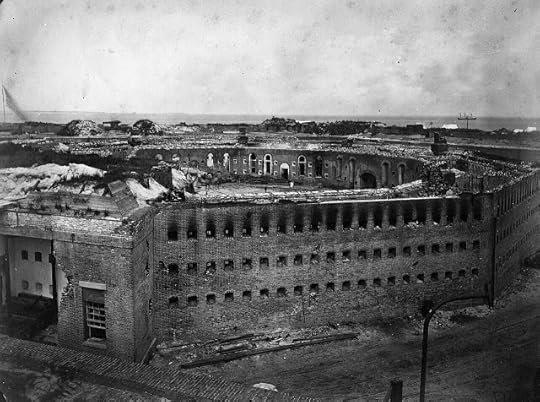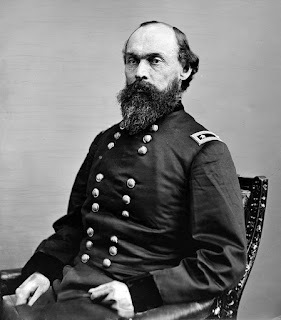Taking Fort Morgan in Mobile Bay
Nearly threeweeks after the Battle of Mobile Bay, Lieutenant Edward N. Kellogg of the U.S.Navy stood outside Fort Morgan as part of the contingent of Federal officerschosen to accept the surrender of Fort Morgan. It proved an impressiveceremony.
"At 2 o’clock that afternoon most of the naval and armyofficers landed at the fort to witness the raising of the old flag over thestronghold that has kept us so long at bay,” he wrote. “The Rebel troops, 560in number, were marched out and stacked arms, and equal number of our own marcheddown in front of the line, the band playing “Hail Columbia,” the “Star-SpangledBanner,” and “Yankee Doodle” among other patriotic airs till they were abreastwhen they halted and faced the graybacks at a distance of ten feet. TheAmerican colors were now run up on the flagstaff and the Rebel flag hauleddown. The band again struck up, the whole fleet fired a salute, the vessels insuccession according to rank and a battery of two field pieces on shore contributingto the grand chorus. In the meantime, “Old Page,” who had turned his back asthe band passed, came between the lines of soldiers where the officers were mostlyassembled and surrendered his flag, fort, garrison, and everything thereuntobelonging unconditionally.”
Lieutenant Kellogg’s letter describing the surrender of FortMorgan first saw publication in the September 10, 1864, edition of the WaukeganWeekly Gazette.
 The smoke-stained ruins of Fort Morgan show the impact of Federal shelling in this image taken shortly after the fort's surrender in August 1864. After touring the fort, Lieutenant Kellogg described the fort's interior was "one mass of rubbish." The fleet threw more than 3,000 shells into the fort on August 22nd and the resulting fire threatened to ignite the powder magazine. Confederates rolled the powder drums into a cistern to prevent their detonation but without powder were essentially rendered defenseless.
The smoke-stained ruins of Fort Morgan show the impact of Federal shelling in this image taken shortly after the fort's surrender in August 1864. After touring the fort, Lieutenant Kellogg described the fort's interior was "one mass of rubbish." The fleet threw more than 3,000 shells into the fort on August 22nd and the resulting fire threatened to ignite the powder magazine. Confederates rolled the powder drums into a cistern to prevent their detonation but without powder were essentially rendered defenseless.
U.S. Steamsloop Oneida, Mobile Bay, Alabama
August 24,1864
Victory once more perches upon thebanner of freedom and the Mobile blockade is now classed among the things thatwere. Day before yesterday the fleet and shore batteries opened the bombardmentand kept it up all through the day. The monitors and double-enders only of thefleet firing during the day. At dark, the citadel inside the fort was seen tobe on fire and the firing was kept up with greater spirit than during the day.Our fire was so hot the Rebel garrison could not fire a gun during part of thebombardment but kept safely sheltered in their casemates. The sharpshooters onshore were so near the fort that it was certain death for a Rebel to show hishead above the parapet. Our fire completely enfiladed the fort as the insideand outside fleet and shore batteries played on all parts simultaneously, everypart being exposed to a murderous fire.
 Brigadier General Richard L. Page
Brigadier General Richard L. Page"Ramrod Page"
Yesterday morning at daylight a whiteflag was hoisted on the parapet of Fort Morgan and the firing ceased. A smallboat with a flag of truce was soon seen putting out for the flagship butGeneral Gordon Granger who was on a small steamer in the bay, interrupted itand brought it alongside his own vessel. The officer of the boat was the bearerof a dispatch from “Ramrod Page,” as he was familiarly nicknamed in our army previousto his turning traitor, proposing terms of surrender.
At 2 o’clock that afternoon most ofthe naval and army officers landed at the fort to witness the raising of theold flag over the stronghold that has kept us so long at bay. The Rebel troops,560 in number, were marched out and stacked arms, and equal number of our ownmarched down in front of the line, the band playing “Hail Columbia,” the “Star-SpangledBanner,” and “Yankee Doodle” among other patriotic airs till they were abreastwhen they halted and faced the graybacks at a distance of ten feet. TheAmerican colors were now run up on the flagstaff and the Rebel flag hauleddown. The band again struck up, the whole fleet fired a salute, the vessels insuccession according to rank and a battery of two field pieces on shore contributingto the grand chorus. In the meantime, “Old Page,” who had turned his back asthe band passed, came between the lines of soldiers where the officers were mostlyassembled and surrendered his flag, fort, garrison, and everything thereuntobelonging unconditionally.
 General Gordon Granger
General Gordon GrangerWe now entered the fort and found thatthe 11- and 15-inch shells had effectually done their work. Fifteen guns weredismounted or entirely disabled. The citadel was completely destroyed by beingset afire by our shells and the whole inside of the fort was one mass ofrubbish that was knocked down from the walls. The garrison with enoughprovisions might have held out for months without any loss of life if they hadbeen disposed but it would have been useless for them to have suffered the annoyanceof broken sleep, imprisonment in the casemates, and perhaps sickness among manyother evils with no hope of reinforcements or supplies. If Page could havefired his guns they would probably have held out much longer. There were fourmonths of provisions in the fort and the garrison had been put on reducedrations the day we entered.
The Rebel guns were of English and Rebel make principally:the 7-inch Brooks’ rifle being one of the best guns in the world. It was one ofthese guns that wounded our captain, exploded our boiler, and disabled ourafter 11-inch gun. I was pleased to see the gun with one trunnion knocked offand otherwise disabled. [Please see my previous post “Bones in the Brackets: AGraphic Account of the Battle of Mobile Bay” for further details on the Oneida’sfight on August 5, 1864.]
The capture of Fort Morgan places usin possession of the whole bat as far up as Long River Bar about five milesfrom the city. Some hard fighting will yet have to be done before the citysurrenders but that work will devolve upon the monitors and small gunboats, thelarge ships not being able to get up so far. Thus far, the port is sealed againstblockade running and the large fleet now here will be released from blockadeduty. The city of Mobile can be easily reached by the guns of our fleet as someof our vessels have already been within three miles of the city.
Our ship will leave soon either forPensacola or New Orleans for necessary repairs before proceeding north. Deadbodies are floating by the ship every day, drifting back and forth with thetide. (To read Lieutenant Kellogg's account of the Battle of Mobile Bay, click here to read "Bones in the Brackets: A Graphic Account of the Battle of Mobile Bay.")
Source:
Letter fromLieutenant Edward Nealley Kellogg, U.S.S. Oneida, Waukegan Weekly Gazette(Illinois), September 10, 1864, pg. 3
Daniel A. Masters's Blog
- Daniel A. Masters's profile
- 1 follower



